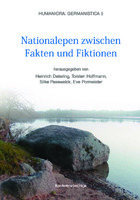Nationalepen zwischen Fakten und Fiktionen
| dc.contributor.author | Detering, Heinrich | |
| dc.contributor.author | Hoffmann, Torsten | |
| dc.contributor.author | Pasewalck, Silke | |
| dc.contributor.author | Pormeister, Eve | |
| dc.date.accessioned | 2012-09-04 00:00:00 | |
| dc.date.accessioned | 2020-04-01T15:17:53Z | |
| dc.date.available | 2020-04-01T15:17:53Z | |
| dc.date.issued | 2011 | |
| dc.identifier | 425571 | |
| dc.identifier | OCN: 1030814280 | en_US |
| dc.identifier.issn | 1736–4345 | |
| dc.identifier.uri | http://library.oapen.org/handle/20.500.12657/34477 | |
| dc.description.abstract | Since the 19th century national epics have had an important function in the cultural scene of almost every nation, and the same is true for the Central and East European countries that have regained their independence after 1989. The programmatic national epic was brought to life by the German Romanticism, especially by writers such as Jacob and Wilhelm Grimm. The contributions in this volume analyse the development, relationship, and reception of European national epics. They rely on a wide concept of epic and offer studies on various texts, such as the Icelandic sagas, the „Nibelungenlied“, the „Poems of Ossian“, the „Kinder- und Hausmärchen“ of the Grimm brothers, Schiller’s „Wilhelm Tell“, Božena Němcová’s „Babička“, Esaias Tegnér’s verse epic „Frit(h)iofs saga“, the Finnish national epic „Kalevala“ and the Estonian national epic „Kalevipoeg“. | |
| dc.language | German | |
| dc.relation.ispartofseries | Humaniora: Germanistica | |
| dc.subject.classification | thema EDItEUR::D Biography, Literature and Literary studies::D Biography, Literature and Literary studies::DS Literature: history and criticism | en_US |
| dc.subject.other | Fictionality | |
| dc.subject.other | Ossian | |
| dc.subject.other | Heiner Müller | |
| dc.subject.other | Johann Gottfried Herder | |
| dc.subject.other | Nationsbildung | |
| dc.subject.other | Nation building | |
| dc.subject.other | Nationalepos | |
| dc.subject.other | Authentizität | |
| dc.subject.other | Identitätskonstruktionen | |
| dc.subject.other | Nationaldichtung | |
| dc.subject.other | National poetry | |
| dc.subject.other | Construction of identity | |
| dc.subject.other | Fiktionalität | |
| dc.subject.other | National epic | |
| dc.subject.other | Authenticity | |
| dc.subject.other | Kalevipoeg | |
| dc.title | Nationalepen zwischen Fakten und Fiktionen | |
| dc.type | book | |
| oapen.abstract.otherlanguage | Seit dem 19. Jahrhundert übernehmen Nationalepen eine wichtige Funktion im kulturellen Haushalt fast jeder Nation – wie sich nicht zuletzt in den nach 1989 neu entstandenen Ländern (Mittel-)Osteuropas eindrücklich bestätigt hat. Installiert worden ist das nationalepische Programm von der deutschen Romantik, insbesondere von Jacob und Wilhelm Grimm. Die in diesem Band versammelten Aufsätze analysieren die Entstehung, die Vernetzung und die Rezeption von europäischen Nationalepen. Ausgehend von einem weiten Epos-Begriff wenden sich die Beiträge solchen Texten zu, die für die Nationsbildung konstitutive Bedeutung erhalten sollten, wie den Isländersagas, dem „Nibelungenlied“, den „Poems of Ossian“, den „Kinder- und Hausmärchen“ der Brüder Grimm, Schillers „Wilhelm Tell“, Božena Němcovás „Babička“, Esaias Tegnérs Versepos „Frit(h)iofs saga“, dem finnischen Nationalepos „Kalevala“ und dem estnischen Nationalepos „Kalevipoeg“. | |
| oapen.identifier.doi | 10.26530/OAPEN_425571 | |
| oapen.relation.isPublishedBy | fed215d9-bf7f-466c-a9f3-5510b4847c64 | |
| oapen.series.number | 5 | |
| oapen.pages | 321 | |
| oapen.place.publication | Tartu | |
| oapen.remark.public | Relevant Wikipedia pages: Epos - https://de.wikipedia.org/wiki/Epos; Kalevipoeg - https://de.wikipedia.org/wiki/Kalevipoeg; Nationalepos - https://de.wikipedia.org/wiki/Nationalepos | |
| oapen.identifier.ocn | 1030814280 |

